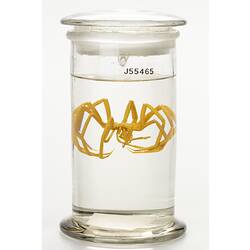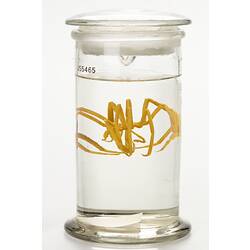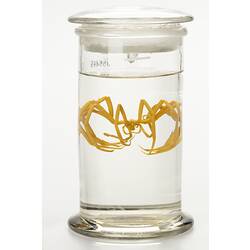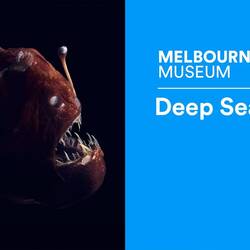General Description
Decolopoda australis is a large, 10-legged Antarctic sea spider, that in life is a bright scarlet colour (although preserved specimens often appear yellow). Diameter exceeds 30cm.
Biology
Pycnogonids have been given the common name 'sea spiders' thanks to their spider-like appearance with long, gangly legs and Decolopoda australis has 10 of these. While its diet is unknown, it has a large robust proboscis (straw-shaped with terminal mouth) which curves downwards so that the mouth would be horizontal to the substrate. As with other sea spiders, rather than dedicated organs, respiration occurs by gaseous exchange through the cuticle wall, digestion is intracellular, and blood circulation is largely activated by movement such as pumping their legs. Eyes are simple and sit on an 'eye tower' called an eye tubercle. Decolopoda australis is one of only a few species of sea spider that exhibits 10 or more walking legs. The five pair of lateral processes to which the ten legs are attached, are crowded, and arranged in such a way that the body appears to have a discoid shape. The structure of appendages such as chelifores, palps and ovigers can help classify distinct species of sea spiders. In this species the anterior chelifores over-reach the proboscis and consist of two-segmented scapes and tong-like, gaping chela (made up of a palm and two fingers). The chelae fingers in this genus have the moveable finger dorsal-most. It is believed that Decolopoda australis and other giant sea spiders can reach enormous sizes because of the oxygen rich and highly stable conditions present in the Antarctic benthic environment.
Distribution
Antarctic distribution, circumpolar. Depth range littoral-1890 m. It has one of the widest bathymetric ranges of any pycnogonid.
More Information
-
Animal Type
-
Animal SubType
-
Fast Fact
Decolopoda australis was the first sea spider to be discovered with more than 8 legs. Unfortunately, it was described at a time when eight legs were considered a diagnostic character of sea spiders and it took more expeditions and specimens before the original description (by Eights in 1835) was finally accepted by all. Imagine the interest when explorer Sir Douglas Mawson returned from the British, Australian and New Zealand Antarctic Research Expedition 1929-1931 with a 12-legged specimen!
-
Brief Id
Large, robust, 10-legged sea spider with discoid appearance
-
Colours
Red, Yellow
-
Maximum Size
30 cm
-
Habitats
-
Diet
Not known
-
Endemicity
-
Conservation Statuses
-
Depths
Deep ( > 30 m), Shallow (1-30 m)
-
Water Column Locations
On or near seafloor
-
Taxon Name
-
Scientific Author
Eights, 1835
-
Common Name
Ten-legged Sea Spider
-
Phylum
-
Subphylum
-
Class
-
Family
-
Genus
-
Species Name
australis




